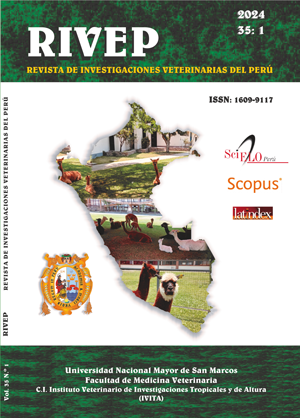Biological, physicochemical and technological potential evaluation of the blue shark (Prionace glauca) from the Peruvian South Pacific
DOI:
https://doi.org/10.15381/rivep.v35i1.27376Keywords:
blue shark, allometry, yield, mineral profile, proximal chemical compositionAbstract
The aim of this study was to evaluate the biological, physicochemical and technological related characteristics of the blue shark Prionace glauca. The sample included 128 specimens to determine their biological and technological properties and 27 specimens for their physicochemical characteristics. Biometric data of length and weight (142 to 281 cm and 10.5 to 93.0 kg for males; 153.5 to 255.0 cm and 14.5 to 80.0 kg for females), allometry index (males 3.27 and females 2.87), technological potential through different types of performance (RED: 83.9±0.03%, RESV: 67.2±0.04%, RSCV: 48.9±0.07% and RPC: 33.5±0.07%) and water retention capacity in the muscle (16.1±0.03%). Within the physicochemical characteristics, the proximal chemical composition was analysed (protein 21.8±0.23; fat 0.6±0.03; humidity 78.0±0.31; ash 1.3±0.01) and mineral composition (Cu: 2.0±0.11 mg/kg; Fe: 17.8±1.95 mg/kg; Zn: 25.8±1.76 mg/kg; Ca: 4.3±0.27 mg/100 g; Mg: 95.4±7.87 mg/100 g; Na: 716.3±24.03 mg/100 g; K: 1526.1±54.4 mg/100 g; P: 439.5±15.76 mg/100 g). There was no evidence of significant differences based on sex.
Downloads
Downloads
Published
Issue
Section
License
Copyright (c) 2024 Daniel Pariona-Velarde, Andrés Reátegui-Quispe

This work is licensed under a Creative Commons Attribution 4.0 International License.
AUTHORS RETAIN THEIR RIGHTS:
a. Authors retain their trade mark rights and patent, and also on any process or procedure described in the article.
b. Authors retain their right to share, copy, distribute, perform and publicly communicate their article (eg, to place their article in an institutional repository or publish it in a book), with an acknowledgment of its initial publication in the Revista de Investigaciones Veterinarias del Perú (RIVEP).
c. Authors retain theirs right to make a subsequent publication of their work, to use the article or any part thereof (eg a compilation of his papers, lecture notes, thesis, or a book), always indicating the source of publication (the originator of the work, journal, volume, number and date).



